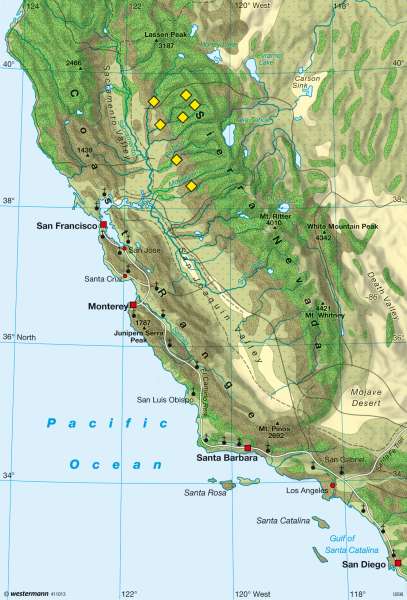California — Land use circa 1830
U.S.A. - Past and present
978-3-14-100790-9 | Page 137 | Ill. 4

Information
In 1830, California was hardly affected by man as it was still covered largely by natural vegetation. The mountains were occupied by sclerophyllous woodlands and in the southwest and east of the Sierra Nevada mountain range (in the rain shadow) were semi-deserts and deserts. The Sacramento Valley was largely taken up by scrub and desert steppe.Settlement
Clearly, the Spanish influence comes from the settlement and development of the area, as it was at first a vice-kingdom of Spain before belonging to Mexico from 1821. Along the "Royal Road" (El Camino Real) Spanish places, forts and church missions were built. The Spanish names, such as San, Santa, indicate these origins. The establishment of the Spanish mission churches is mainly due to the Franciscan Junipero Serra (1713—84) — and south of Monterey, the peak is named Junipero Serra Peak after him. From 1769—84, he founded the first nine mission churches between San Diego and San Francisco, each 50—75 miles apart. Under his successor, nine more missions were built up until 1803, to reduce the distances between them and strengthen the entire colonisation. With the establishment of the final mission (in 1823), north of San Francisco, 21 missions existed on the 500-mile circuit. There were also military forts (Presidios).
Gold Rush
In the northern Sierra Nevada, gold deposits were discovered in 1848 and caused a large influx of "Gold Rush" prospectors. As a result, the population of California rapidly increased from approximately 12,000 (non Indians) and at the time of the emergence of the state of California in 1850, the population soared to reach 92,000.
W. Klohn; Ü: C. Fleming




